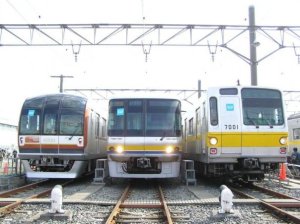 Andrew McKillop
Andrew McKillop
21st Century Wire
We are facing a very real kind of event horizon. Car industry and car fleet growth is accelerating so fast that we may find ourselves in a “can’t get there from here” resource pinch, with no alternative and no way out, starting with an oil supply shortage.
Until very recently exploding numbers of oil- and gas-fuelled road vehicles, including cars, buses, trucks, motorcycles, scooters, mopeds, all terrain ‘fun’ vehicles, and agricultural ‘off-road’ vehicles increasingly used for road transport (Footnote) have drawn much less attention than human population numbers. This is curious given the rate of increase, shown by a few simple figures: in 1939 the world’s roughly 2.3 Billion inhabitants shared a total of around 47 Million motor vehicles.
Today’s 6.3 Billion human beings have around 775 Million motor vehicles to fuel, repair, park and run, almost exclusively using petroleum and natural gas. Human numbers increased less than three-fold, but the world’s car population grew by a staggering 1750%.
.
THE EXPLODING NUMBERS
Today’s human population is growing at less than 1.4% per year (giving about 85 Million annual increase), but the world’s car and private motor vehicle fleets are growing at close to 7%-per-year. Production of oil-fuelled motor vehicles is therefore increasing at least 4 times faster than human numbers in percentage terms. In several ‘latecomer’ and ‘catch up’ countries vehicle manufacture is increasing output and utilisation of road vehicles at 10-15 times their rate of human population growth, and at several times their rate of economic growth (Reference 1).
One thing is sure: motor vehicles, a key part of Consumer Civilisation, generate dramatic increases in personal consumption of oil and gas, probably in the range of 50-100 times comparing ‘before car’ and ‘after car’ consumption habits or ‘needs’.
THE UPPER LIMITS
Just as with the ultimate Heat Limit on world human population numbers (see ‘Moral Dilemma’ by Ross McCluney, in ‘The Final Energy Crisis’, Pluto Books, ISBN 0745320929), fixing a true and final limit on human numbers, there are set and final limits on the possible growth of motor vehicles.
These finally include the world’s ultimate reserve of petroleum, unless we wish to fantasize, along with then US Energy Secretary Spencer Abraham, by giving any credence at all to his November 2002 statement that the world « will have a total of 3.5 Billion motor vehicles by 2050. If this fantasy fleet were to come about – adding about 2.7 Billion more vehicles to the world’s current stock – the fuel requirements for 3.5 Bn motor vehicles, at current average consumption rates (see calculations at end of article) would increase world oil consumption by about 70%. Because it is simply impossible to fuel this Fantasy Fleet on oil and gas, Abraham added that they would ‘of course run to a large extent on hydrogen’ (the ‘large extent’ was not defined by Mr Abraham), and the production of that hydrogen fuel he also of course did not define or explain.
To set the ultimate limit for the growth of petroleum and gas-fuelled vehicles we can start with the near-ultimate example of a ‘catch-up’ country in the car business – Japan. Even as late as 1949 Japan still had some 146 500 horse- and ox-drawn carts compared with less than 200 000 trucks (and about 100 000 private automobiles). But through a self-reinforcing, very high gain feedback process of growth, with annual growth rates typically of 15% – 20%, year-in and year-out, Japan’s private car fleet explosively grew from these small beginnings to its first million in 1963, to 5.2 Million in 1968, and to some 26 Million by 1982. Annual growth rates had by then considerably slowed, but fleet size effects still permitted this slowed growth to give impressive annual increases; today’s total number is about 45 Million private vehicles (References Tadashi, Shimokawa, Japan Dept Transport).
To get on the growth track, Japan’s administrative élite, even after the culture shock of atomic weapons use against their civilian population, and military rule by US governor MacArthur, had to throw off mindsets dating from the 1918-39 interwar period, when road vehicles were seen as simple ‘feeders’ for short-haul transport to rail, canal, river and coastal shipping points or transport nodes. Japan’s domestic policymakers, at the start of the post-war period under US occupation, thus preferred to spend money on repairing and improving the rail, shipping and public transport sectors.
In addition, their policy view downgrading road vehicles was reinforced by Japan’s terrain, its dense urban centres, and by Japanese feelings of doubt on the safety of cars: Because of slow improvement of the country’s narrow, often mountainous roads, the government tended to discriminate against motor transport on grounds of road safety. City streets were often dangerous too. There was strict traffic control, rigorous tests for driving licences and careful inspection of all new vehicles, both home manufactured and imported. A high standard of maintenance was promoted and the manufacture of reliable, safe cars was encouraged (Ref Shimokawa).
.
The date at which Japanese transport policy switched to outright pro-car can be set as the period of about 1955-60, the period in which animal-powered transport completely disappeared in the agriculture sector, together with the catch-up economic growth that Japan experienced from around 1958. Despite this, however, as late as the early 1960s, Japan’s Economic Planning Agency continued to purposely underestimate forward growth of road needs for the exploding vehicle population (Reference Konno & Okano).
Today, as the ongoing ‘restructuring’ of Japan’s national railway corporation proves – that is the effective bailout of an underfinanced, neglected public transport system – public rail transport in Japan, as in its ‘US role model’, is a dwarf compared to the road vehicle sector. As elsewhere in the “liberalized economies” of the aging OECD group of countries, Japan’s national passenger transport depends almost entirely on the existence of oil-fuelled private road vehicles running on oil-based asphalt and bitumin.
THE SECOND COMING
While the USA, and surprisingly New Zealand, were the fastest growing countries for motorization in the entire period of 1905-1940, achieving ownership rates for private cars of nearly 300 vehicles/1000 inhabitants in 35 years despite starting from a near-zero base (Reference Barker), their growth rates peaked out well before World War 2. These countries, with all the older urban-industrial countries, however experienced a “second coming” from the early to mid 1950s. Countries such as Canada, Australia, Italy, UK, France and Germany, experienced a new car ownership growth bulge in the 1950-70 period. Typical growth rates were around 500% in 20 years, for example the UK with a 6-fold growth in car and private vehicle numbers through 1950-70 (Reference SMMT). At the time of the first Oil Shock of 1973-74 it was only Japan that experienced a strong but short downturn in this ‘motorization’ trend.
From no later than 1975-80 the tried-and-tested ‘economic growth model’ of car-based and car-oriented growth- a key concept in economic mythology from the times of Henry Ford in the 1920s USA, was transferred and applied with full force in several non-traditional car owning democracies, and dictatorships of the time, including South Korea, Brazil, Malaysia, Turkey, Iran, the Soviet Asian Republics. Somewhat later (from the later 1980s) but with truly unlimited upside potential, this growth strategy was adopted by China and India.
Today, in countries such as Germany, USA, France and Australia there is no difficulty finding 3 and 4-car households, nor 25-mile tailbacks every weekday on every main highway into congested, sprawling and polluted downtown centres. The same is to be found in Sao Paulo, Bangkok, Ankara, Seoul and Kuala Lumpur. Shanghai is already close behind in the race to have daily crawl-ins on its fast expanding auto routes and urban highways.
Explaining the “oil demand miltiplier” inherent in motorization, a vast range of products arising from the magic of petroleum-based chemicals industries are essential to the modern private motor vehicle industry, notably plastics and resins. As in Henry Ford’s time – when animal bone and ligaments, skins, wood and wood resins were still extensively used in car manufacture – the economic multiplier impacts of ‘unfettered growth’ of the car industry remain highly attractive to economic planners, resulting in motorization continuing to spread out and away from the core countries of the ageing ‘advanced industrial’ OECD North.
EVENT HORIZON: THE ULTIMATE LIMIT
There are however distinct limits on the ultimate reach of this tried-and-tested ‘growth strategy’. Today’s private car and small vehicle ownership rate in the USA is around 745 vehicles / 1000 inhabitants, with lower but similar rates (around 500-650 vehicles/1000 population) obtaining in Belgium, Germany, France, UK and other car-saturated economies. Applying the same ownership rate to India or China, and assuming these motor vehicles would, could, may or might be oil or gas-propelled, results in absurd numbers for annual oil or oil equivalent gas consumption. In the case of China’s car fleet we are already, using World Bank data for 1990-99, at the fantastic but real average annual growth rate of about 19%, doubling China’s car population every 4 years. (Footnote/Recent growth).
The following is of course a fantasy projection, but its only proviso is that India and China should firstly sustain the growth rates for car production and ownership that were experienced by the USA, New Zealand, Canada, Australia, Japan, France, Germany and other ‘leading industrial nations’, for a period of less than 20 years. If their growth rates are higher, the period needed to attain ‘saturation ownership’ (the USA’s current rate) will of course be lower. If China and India were to achieve this, the entire oil exports of the OPEC group would not even satisfy these two country’s car fleet requirement for oil (or LPG/LNG) !
So the fantasy ‘Hydrogen Economy’ is therefore the only way out for current political and business leaderships – when or if they care to forecast any further out in time than a mere 5 – 10 years.
Average European vehicle kilometrage per year EUR-6 (core 6 nations) is 22 000 kms/vehicle/year. EUR-15 average is lower. Both average figures are rising with economic growth and declining real cost of energy. Average vehicle occupancy 1.5 persons Annual mileage averages are not set to fall, nor occupancy figures to rise except by decree- or other draconian measures resulting from real oil shocks, for example oil prices well above $100/barrel.
Average fleet-wide car fuel consumption in Germany is 7.9 L/100 kms vehicle but we will assume that this is rapidly reduced, for India and China, to two-thirds of that value, or 5.267 L/100 kms. We will also assume that India and Chinese cars will only travel 18 000 kms/year.
Total oil consumption at 5.96 Barrels (948 Litres) per car per year is as follows:
Using future population figures (assuming complete zero population growth) of 1 Billion for India and 1.25 Billion for China, we obtain a Future Car Fleet at the ‘saturation ownership’ rate of 745 vehicles/1000 population of 745 Million vehicles (India) and 932 Million vehicles (China). At 5.96 barrels/year for each vehicle their consumption is approximately 5.54 Billion barrels/year for China and 4.44 Billion barrels/year for India… for a grand total of almost exactly 10 Billion barrels/year, and equivalent to 27.4 Million barrels/day. This is about three times the total oil imports of all EU countries in 2002, nearly 3 times the maximum possible production capacity of Saudi Arabia, and slightly more than the total average export volume of the OPEC group around mid-2003
(Calculations by A McKillop).
FIGHTING FOR FUEL
We therefore have a laughable fantasy, or an insight into exactly why three nuclear armed powers, China, India and USA, are ever more likely to fight amongst themselves, or confront EU importers, including 2 nuclear weapons states for the last oil reserves of the planet.
Under any hypothesis – excluding childish technological fantasies and utopias such as those trotted out by Amory Lovins or US Energy Secretary Abraham – there is simply no prospect of China, India, or other countries including Malaysia, Brazil, Turkey, Iran, Ukraine, Mexico, the Czech Republic and other emerging car producers being able to achieve US, West European, Australian or Japanese rates of car production and ownership. The Chinese Car Bomb therefore ticks onward, as each day another estimated 112,190 cars are produced (Reference Motorcity). Each one requires up to 55 barrels of oil equivalent to produce, and must operate on bitumin based highways, on tyres that themselves are about 40% oil by weight.
Not only is this explosion of the world car fleet a serious threat to the Earth’s environment, but through its oil demand impact most certainly will become a major threat to international peace and stability. Meanwhile, our friends at Central Planning are still busy debating which is the ideal green dream car. So it looks as if plans to diffuse the Chinese Car Bomb and its little sister- the Indian Car Bomb, will not be underway anytime soon.
COPYRIGHT ANDREW MCKILLOP 2011
–
Andrew McKillop is guest writer for 21st Century Wire. He has more than 30 years experience in the energy, economic and finance domains. Trained at London UK’s University College, he has had specially long experience of energy policy, project administration and the development and financing of alternate energy. This included his role of in-house Expert on Policy and Programming at the DG XVII-Energy of the European Commission, Director of Information of the OAPEC technology transfer subsidiary, AREC and researcher for UN agencies including the ILO.
***
REFERENCES AND FOOTNOTES:
Footnote – Offroad and agricultural motor vehicles are in fact extensively, perhaps increasingly used for human and good transport on roads and tracks. This is notably the case in China and India, where the current lack of road motor vehicles incites the usage of agricultural vehicles for human transport (passengers riding in towed trailers). It can be noted that fuel efficiency of these ‘road vehicles’ is very low because of technical reasons, that is vehicles designed for slow speed offroad being used for road transport.
Reference 1 http://www.geocities.com/MotorCity/Speedway/4939/carprod.html. This site provides recent data on worldwide car production (from 1995). The very fast growth rates of car production in several countries (10-15 times their population growth rates) is clear.
References Tadashi, Shimokawa, Jap Dept Transport – M Tadashi, The Motorisation of Cargo Transport in Japan, Hakuto-Shobu, Tokyo, 1982. Japan Dept of Transport for recent data.
K Shimokawa, Japan The Late Starter who Outpaced her Rivals, in The Economic and Social Effects of the Spread of Motor Vehicles, edited T Barker, Macmillan, UK, 1987
Japanese Dept of Transport, White Paper on Transport, Japan Govt, 1984
Reference Shimokawa, as above
Reference Konno & Okano – G Konn and Y Okano, Study of Modern Motor Transport, Tokyo University Press, 1979
Reference Barker – as above
Reference/ Recent Chinese car sales growth – China’s car sales hit one million for first time
[REUTERS DECEMBER 16, 2002]
SHANGHAI: Annual car sales in China have topped the one million mark for the first time as a rising urban middle class crowns the world’s fastest-growing market for foreign automakers, industry executives said on Monday. An official at the China Association of Automobile Manufacturers told Reuters 1.02 million cars were sold in China in the first 11 months of this year, representing a stunning 55.4 per cent jump from the same period in 2001.
Reference SMMT – SMMT (UK Society of Motor Manufacturers and Traders) statistics for 2001 showed the UK having 28.6 million cars and 3.5M commercial vehicles in use. This compares with the UK 1951 car ownership figure of 2.3M, 1971 of 12.35M, and 1981 of 15.63M.
Reference Motorcity – as above. This indicates total production 2001 being about 40.9 Million private cars, or about 112 190 per day, worldwide.
READ MORE CHINA NEWS AT: 21st Century Wire China Files
SUPPORT 21WIRE – SUBSCRIBE & BECOME A MEMBER @21WIRE.TV

















